Critical Analysis of Yoga's Effectiveness in PTSD Treatment Report
VerifiedAdded on 2023/06/03
|8
|2007
|361
Report
AI Summary
This report critically analyzes the effectiveness of yoga as an intervention for post-traumatic stress disorder (PTSD), focusing on a case study involving a 21-year-old computer programmer named Tasso who experienced a motor vehicle accident and was diagnosed with PTSD. The report examines a representative study by Jindani and Khalsa (2015) on a yoga intervention program. It assesses the study's strengths and limitations, research questions, design, methods, and results. The findings suggest that yoga can improve wellbeing, but the report acknowledges the limitations of the study, such as the small sample size and short intervention duration. The report concludes that yoga shows promise as an intervention for PTSD, emphasizing the need for further research to explore its effects on different populations and to understand the underlying mechanisms. The report uses the provided assignment brief to guide the structure and critical analysis, offering insights into evidence-based practices for PTSD treatment and the potential of yoga as a complementary approach.
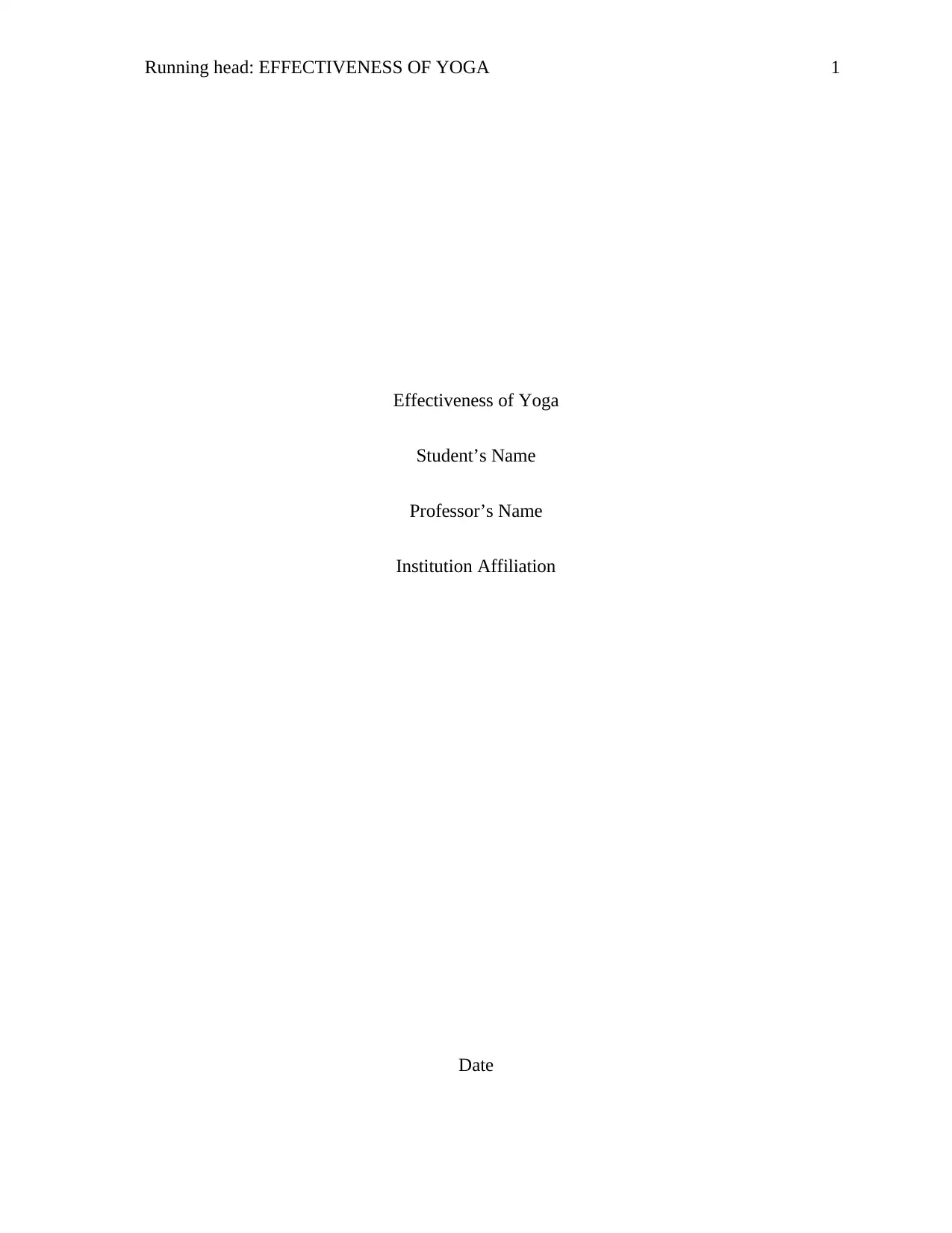
Running head: EFFECTIVENESS OF YOGA 1
Effectiveness of Yoga
Student’s Name
Professor’s Name
Institution Affiliation
Date
Effectiveness of Yoga
Student’s Name
Professor’s Name
Institution Affiliation
Date
Paraphrase This Document
Need a fresh take? Get an instant paraphrase of this document with our AI Paraphraser
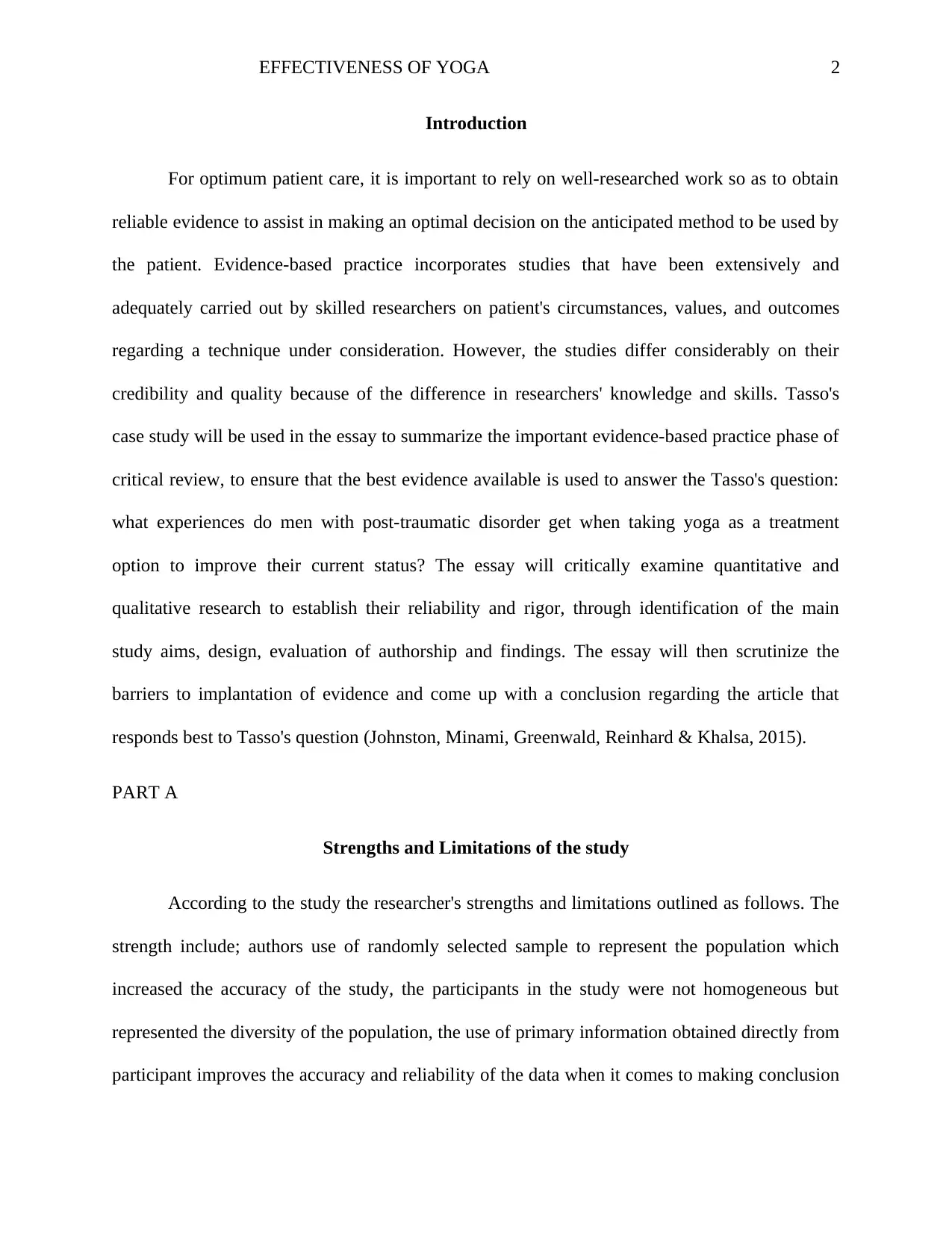
EFFECTIVENESS OF YOGA 2
Introduction
For optimum patient care, it is important to rely on well-researched work so as to obtain
reliable evidence to assist in making an optimal decision on the anticipated method to be used by
the patient. Evidence-based practice incorporates studies that have been extensively and
adequately carried out by skilled researchers on patient's circumstances, values, and outcomes
regarding a technique under consideration. However, the studies differ considerably on their
credibility and quality because of the difference in researchers' knowledge and skills. Tasso's
case study will be used in the essay to summarize the important evidence-based practice phase of
critical review, to ensure that the best evidence available is used to answer the Tasso's question:
what experiences do men with post-traumatic disorder get when taking yoga as a treatment
option to improve their current status? The essay will critically examine quantitative and
qualitative research to establish their reliability and rigor, through identification of the main
study aims, design, evaluation of authorship and findings. The essay will then scrutinize the
barriers to implantation of evidence and come up with a conclusion regarding the article that
responds best to Tasso's question (Johnston, Minami, Greenwald, Reinhard & Khalsa, 2015).
PART A
Strengths and Limitations of the study
According to the study the researcher's strengths and limitations outlined as follows. The
strength include; authors use of randomly selected sample to represent the population which
increased the accuracy of the study, the participants in the study were not homogeneous but
represented the diversity of the population, the use of primary information obtained directly from
participant improves the accuracy and reliability of the data when it comes to making conclusion
Introduction
For optimum patient care, it is important to rely on well-researched work so as to obtain
reliable evidence to assist in making an optimal decision on the anticipated method to be used by
the patient. Evidence-based practice incorporates studies that have been extensively and
adequately carried out by skilled researchers on patient's circumstances, values, and outcomes
regarding a technique under consideration. However, the studies differ considerably on their
credibility and quality because of the difference in researchers' knowledge and skills. Tasso's
case study will be used in the essay to summarize the important evidence-based practice phase of
critical review, to ensure that the best evidence available is used to answer the Tasso's question:
what experiences do men with post-traumatic disorder get when taking yoga as a treatment
option to improve their current status? The essay will critically examine quantitative and
qualitative research to establish their reliability and rigor, through identification of the main
study aims, design, evaluation of authorship and findings. The essay will then scrutinize the
barriers to implantation of evidence and come up with a conclusion regarding the article that
responds best to Tasso's question (Johnston, Minami, Greenwald, Reinhard & Khalsa, 2015).
PART A
Strengths and Limitations of the study
According to the study the researcher's strengths and limitations outlined as follows. The
strength include; authors use of randomly selected sample to represent the population which
increased the accuracy of the study, the participants in the study were not homogeneous but
represented the diversity of the population, the use of primary information obtained directly from
participant improves the accuracy and reliability of the data when it comes to making conclusion
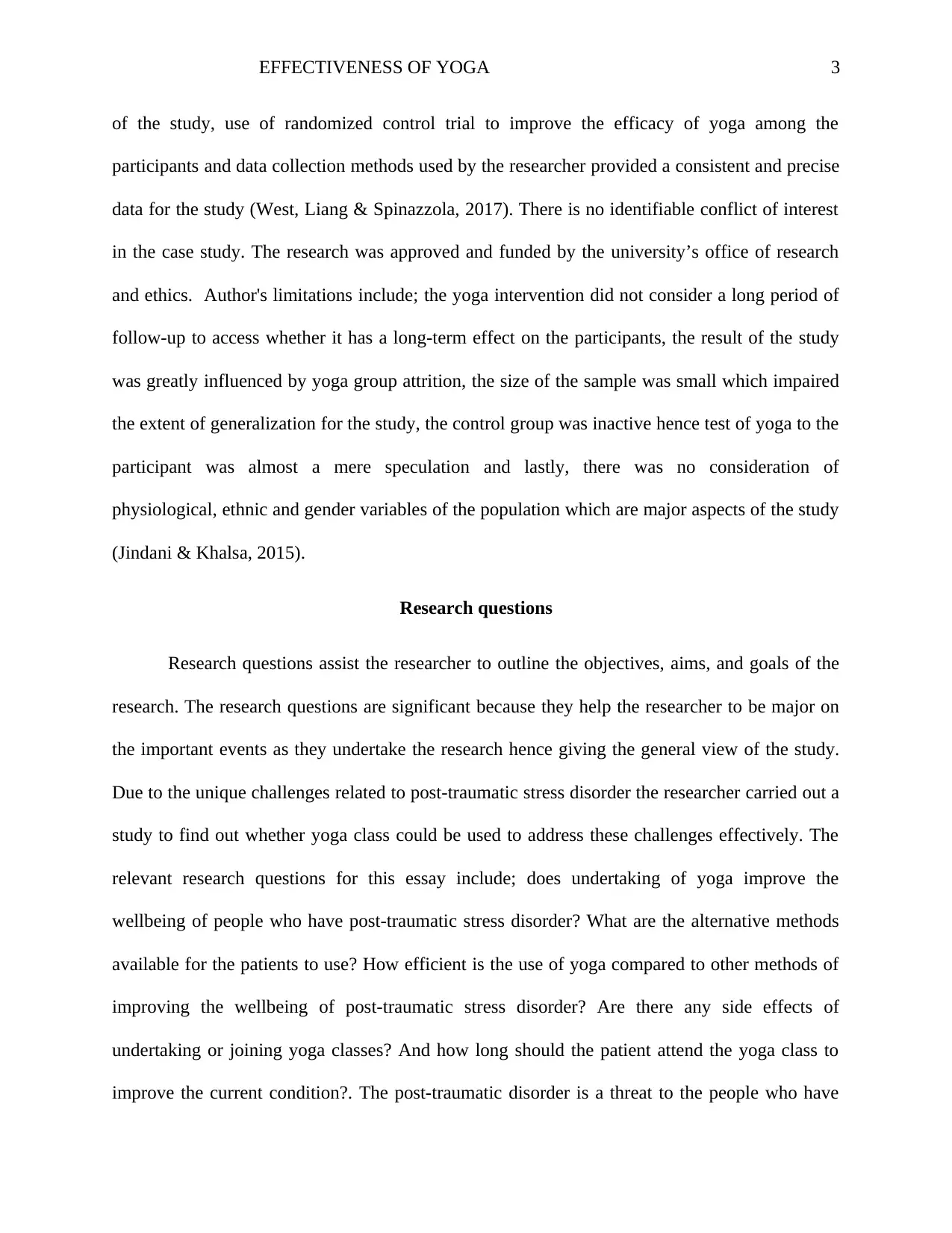
EFFECTIVENESS OF YOGA 3
of the study, use of randomized control trial to improve the efficacy of yoga among the
participants and data collection methods used by the researcher provided a consistent and precise
data for the study (West, Liang & Spinazzola, 2017). There is no identifiable conflict of interest
in the case study. The research was approved and funded by the university’s office of research
and ethics. Author's limitations include; the yoga intervention did not consider a long period of
follow-up to access whether it has a long-term effect on the participants, the result of the study
was greatly influenced by yoga group attrition, the size of the sample was small which impaired
the extent of generalization for the study, the control group was inactive hence test of yoga to the
participant was almost a mere speculation and lastly, there was no consideration of
physiological, ethnic and gender variables of the population which are major aspects of the study
(Jindani & Khalsa, 2015).
Research questions
Research questions assist the researcher to outline the objectives, aims, and goals of the
research. The research questions are significant because they help the researcher to be major on
the important events as they undertake the research hence giving the general view of the study.
Due to the unique challenges related to post-traumatic stress disorder the researcher carried out a
study to find out whether yoga class could be used to address these challenges effectively. The
relevant research questions for this essay include; does undertaking of yoga improve the
wellbeing of people who have post-traumatic stress disorder? What are the alternative methods
available for the patients to use? How efficient is the use of yoga compared to other methods of
improving the wellbeing of post-traumatic stress disorder? Are there any side effects of
undertaking or joining yoga classes? And how long should the patient attend the yoga class to
improve the current condition?. The post-traumatic disorder is a threat to the people who have
of the study, use of randomized control trial to improve the efficacy of yoga among the
participants and data collection methods used by the researcher provided a consistent and precise
data for the study (West, Liang & Spinazzola, 2017). There is no identifiable conflict of interest
in the case study. The research was approved and funded by the university’s office of research
and ethics. Author's limitations include; the yoga intervention did not consider a long period of
follow-up to access whether it has a long-term effect on the participants, the result of the study
was greatly influenced by yoga group attrition, the size of the sample was small which impaired
the extent of generalization for the study, the control group was inactive hence test of yoga to the
participant was almost a mere speculation and lastly, there was no consideration of
physiological, ethnic and gender variables of the population which are major aspects of the study
(Jindani & Khalsa, 2015).
Research questions
Research questions assist the researcher to outline the objectives, aims, and goals of the
research. The research questions are significant because they help the researcher to be major on
the important events as they undertake the research hence giving the general view of the study.
Due to the unique challenges related to post-traumatic stress disorder the researcher carried out a
study to find out whether yoga class could be used to address these challenges effectively. The
relevant research questions for this essay include; does undertaking of yoga improve the
wellbeing of people who have post-traumatic stress disorder? What are the alternative methods
available for the patients to use? How efficient is the use of yoga compared to other methods of
improving the wellbeing of post-traumatic stress disorder? Are there any side effects of
undertaking or joining yoga classes? And how long should the patient attend the yoga class to
improve the current condition?. The post-traumatic disorder is a threat to the people who have
⊘ This is a preview!⊘
Do you want full access?
Subscribe today to unlock all pages.

Trusted by 1+ million students worldwide
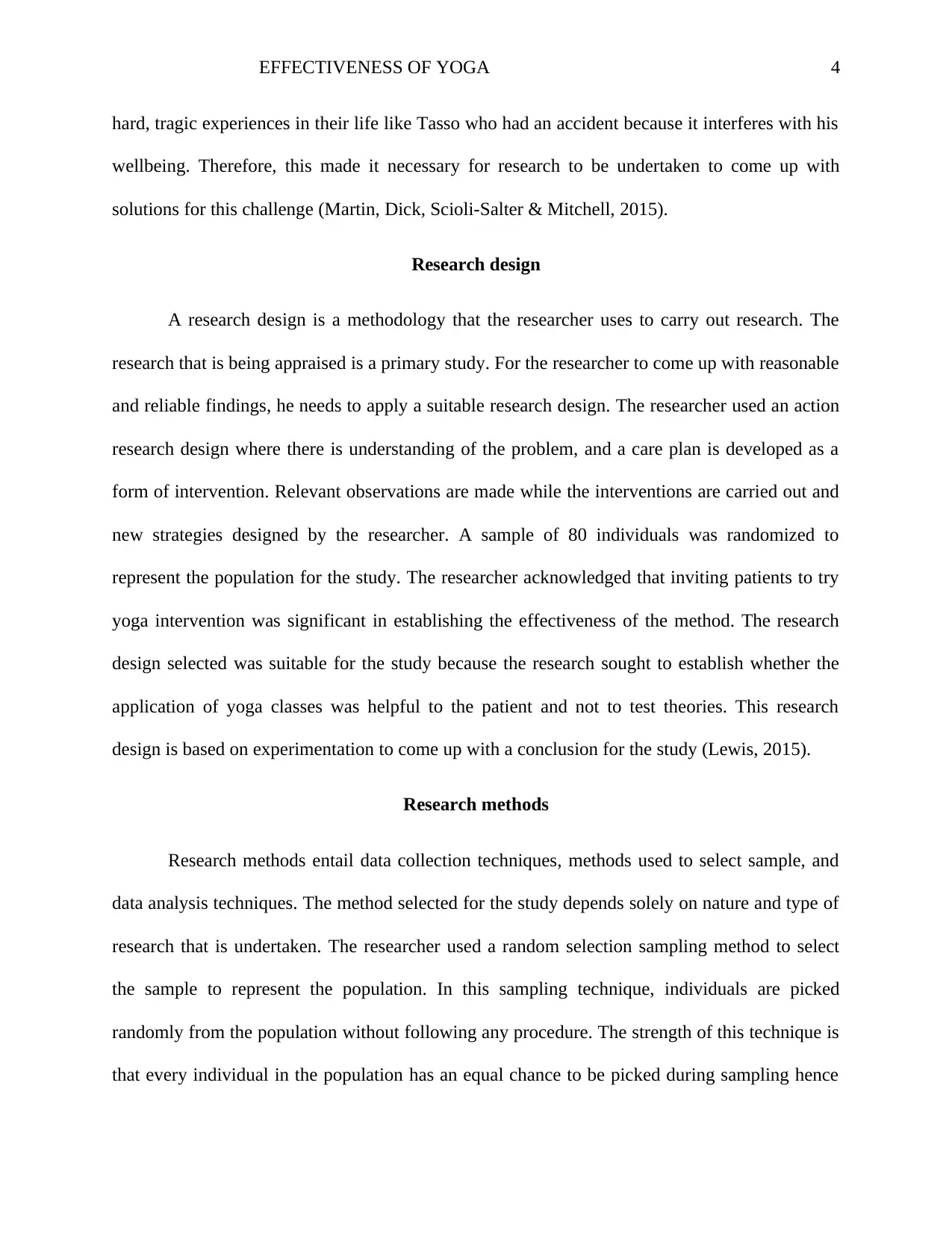
EFFECTIVENESS OF YOGA 4
hard, tragic experiences in their life like Tasso who had an accident because it interferes with his
wellbeing. Therefore, this made it necessary for research to be undertaken to come up with
solutions for this challenge (Martin, Dick, Scioli-Salter & Mitchell, 2015).
Research design
A research design is a methodology that the researcher uses to carry out research. The
research that is being appraised is a primary study. For the researcher to come up with reasonable
and reliable findings, he needs to apply a suitable research design. The researcher used an action
research design where there is understanding of the problem, and a care plan is developed as a
form of intervention. Relevant observations are made while the interventions are carried out and
new strategies designed by the researcher. A sample of 80 individuals was randomized to
represent the population for the study. The researcher acknowledged that inviting patients to try
yoga intervention was significant in establishing the effectiveness of the method. The research
design selected was suitable for the study because the research sought to establish whether the
application of yoga classes was helpful to the patient and not to test theories. This research
design is based on experimentation to come up with a conclusion for the study (Lewis, 2015).
Research methods
Research methods entail data collection techniques, methods used to select sample, and
data analysis techniques. The method selected for the study depends solely on nature and type of
research that is undertaken. The researcher used a random selection sampling method to select
the sample to represent the population. In this sampling technique, individuals are picked
randomly from the population without following any procedure. The strength of this technique is
that every individual in the population has an equal chance to be picked during sampling hence
hard, tragic experiences in their life like Tasso who had an accident because it interferes with his
wellbeing. Therefore, this made it necessary for research to be undertaken to come up with
solutions for this challenge (Martin, Dick, Scioli-Salter & Mitchell, 2015).
Research design
A research design is a methodology that the researcher uses to carry out research. The
research that is being appraised is a primary study. For the researcher to come up with reasonable
and reliable findings, he needs to apply a suitable research design. The researcher used an action
research design where there is understanding of the problem, and a care plan is developed as a
form of intervention. Relevant observations are made while the interventions are carried out and
new strategies designed by the researcher. A sample of 80 individuals was randomized to
represent the population for the study. The researcher acknowledged that inviting patients to try
yoga intervention was significant in establishing the effectiveness of the method. The research
design selected was suitable for the study because the research sought to establish whether the
application of yoga classes was helpful to the patient and not to test theories. This research
design is based on experimentation to come up with a conclusion for the study (Lewis, 2015).
Research methods
Research methods entail data collection techniques, methods used to select sample, and
data analysis techniques. The method selected for the study depends solely on nature and type of
research that is undertaken. The researcher used a random selection sampling method to select
the sample to represent the population. In this sampling technique, individuals are picked
randomly from the population without following any procedure. The strength of this technique is
that every individual in the population has an equal chance to be picked during sampling hence
Paraphrase This Document
Need a fresh take? Get an instant paraphrase of this document with our AI Paraphraser
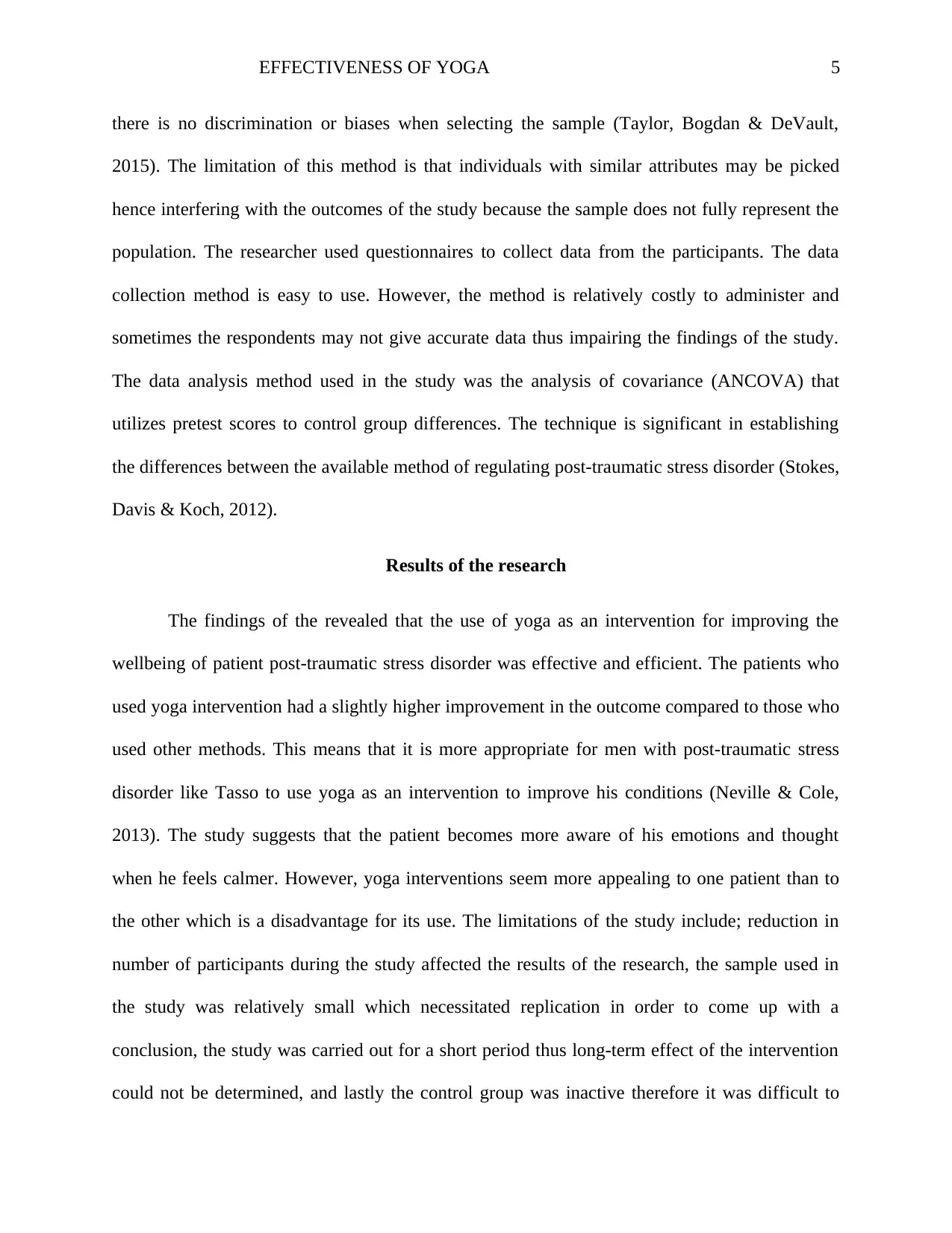
EFFECTIVENESS OF YOGA 5
there is no discrimination or biases when selecting the sample (Taylor, Bogdan & DeVault,
2015). The limitation of this method is that individuals with similar attributes may be picked
hence interfering with the outcomes of the study because the sample does not fully represent the
population. The researcher used questionnaires to collect data from the participants. The data
collection method is easy to use. However, the method is relatively costly to administer and
sometimes the respondents may not give accurate data thus impairing the findings of the study.
The data analysis method used in the study was the analysis of covariance (ANCOVA) that
utilizes pretest scores to control group differences. The technique is significant in establishing
the differences between the available method of regulating post-traumatic stress disorder (Stokes,
Davis & Koch, 2012).
Results of the research
The findings of the revealed that the use of yoga as an intervention for improving the
wellbeing of patient post-traumatic stress disorder was effective and efficient. The patients who
used yoga intervention had a slightly higher improvement in the outcome compared to those who
used other methods. This means that it is more appropriate for men with post-traumatic stress
disorder like Tasso to use yoga as an intervention to improve his conditions (Neville & Cole,
2013). The study suggests that the patient becomes more aware of his emotions and thought
when he feels calmer. However, yoga interventions seem more appealing to one patient than to
the other which is a disadvantage for its use. The limitations of the study include; reduction in
number of participants during the study affected the results of the research, the sample used in
the study was relatively small which necessitated replication in order to come up with a
conclusion, the study was carried out for a short period thus long-term effect of the intervention
could not be determined, and lastly the control group was inactive therefore it was difficult to
there is no discrimination or biases when selecting the sample (Taylor, Bogdan & DeVault,
2015). The limitation of this method is that individuals with similar attributes may be picked
hence interfering with the outcomes of the study because the sample does not fully represent the
population. The researcher used questionnaires to collect data from the participants. The data
collection method is easy to use. However, the method is relatively costly to administer and
sometimes the respondents may not give accurate data thus impairing the findings of the study.
The data analysis method used in the study was the analysis of covariance (ANCOVA) that
utilizes pretest scores to control group differences. The technique is significant in establishing
the differences between the available method of regulating post-traumatic stress disorder (Stokes,
Davis & Koch, 2012).
Results of the research
The findings of the revealed that the use of yoga as an intervention for improving the
wellbeing of patient post-traumatic stress disorder was effective and efficient. The patients who
used yoga intervention had a slightly higher improvement in the outcome compared to those who
used other methods. This means that it is more appropriate for men with post-traumatic stress
disorder like Tasso to use yoga as an intervention to improve his conditions (Neville & Cole,
2013). The study suggests that the patient becomes more aware of his emotions and thought
when he feels calmer. However, yoga interventions seem more appealing to one patient than to
the other which is a disadvantage for its use. The limitations of the study include; reduction in
number of participants during the study affected the results of the research, the sample used in
the study was relatively small which necessitated replication in order to come up with a
conclusion, the study was carried out for a short period thus long-term effect of the intervention
could not be determined, and lastly the control group was inactive therefore it was difficult to
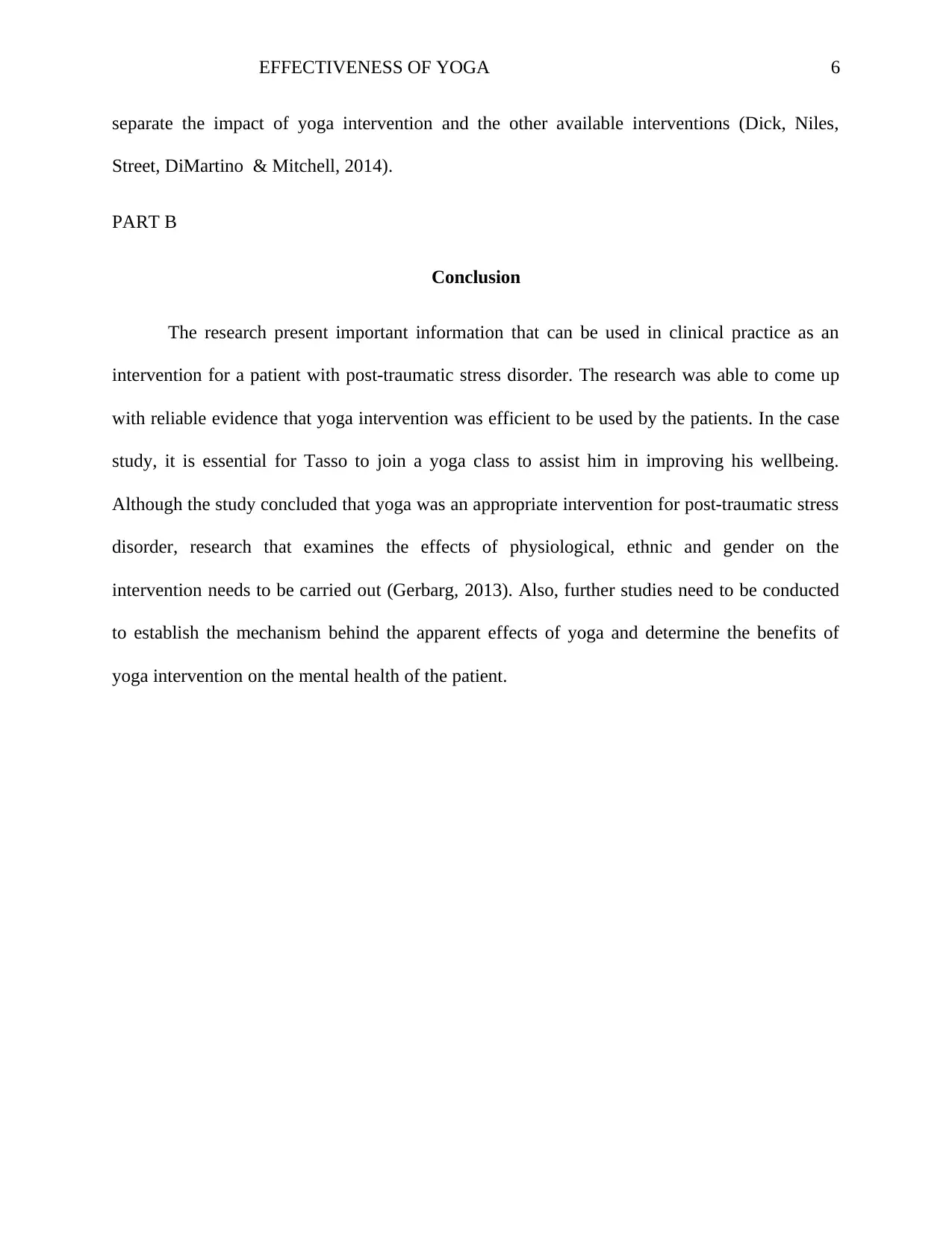
EFFECTIVENESS OF YOGA 6
separate the impact of yoga intervention and the other available interventions (Dick, Niles,
Street, DiMartino & Mitchell, 2014).
PART B
Conclusion
The research present important information that can be used in clinical practice as an
intervention for a patient with post-traumatic stress disorder. The research was able to come up
with reliable evidence that yoga intervention was efficient to be used by the patients. In the case
study, it is essential for Tasso to join a yoga class to assist him in improving his wellbeing.
Although the study concluded that yoga was an appropriate intervention for post-traumatic stress
disorder, research that examines the effects of physiological, ethnic and gender on the
intervention needs to be carried out (Gerbarg, 2013). Also, further studies need to be conducted
to establish the mechanism behind the apparent effects of yoga and determine the benefits of
yoga intervention on the mental health of the patient.
separate the impact of yoga intervention and the other available interventions (Dick, Niles,
Street, DiMartino & Mitchell, 2014).
PART B
Conclusion
The research present important information that can be used in clinical practice as an
intervention for a patient with post-traumatic stress disorder. The research was able to come up
with reliable evidence that yoga intervention was efficient to be used by the patients. In the case
study, it is essential for Tasso to join a yoga class to assist him in improving his wellbeing.
Although the study concluded that yoga was an appropriate intervention for post-traumatic stress
disorder, research that examines the effects of physiological, ethnic and gender on the
intervention needs to be carried out (Gerbarg, 2013). Also, further studies need to be conducted
to establish the mechanism behind the apparent effects of yoga and determine the benefits of
yoga intervention on the mental health of the patient.
⊘ This is a preview!⊘
Do you want full access?
Subscribe today to unlock all pages.

Trusted by 1+ million students worldwide
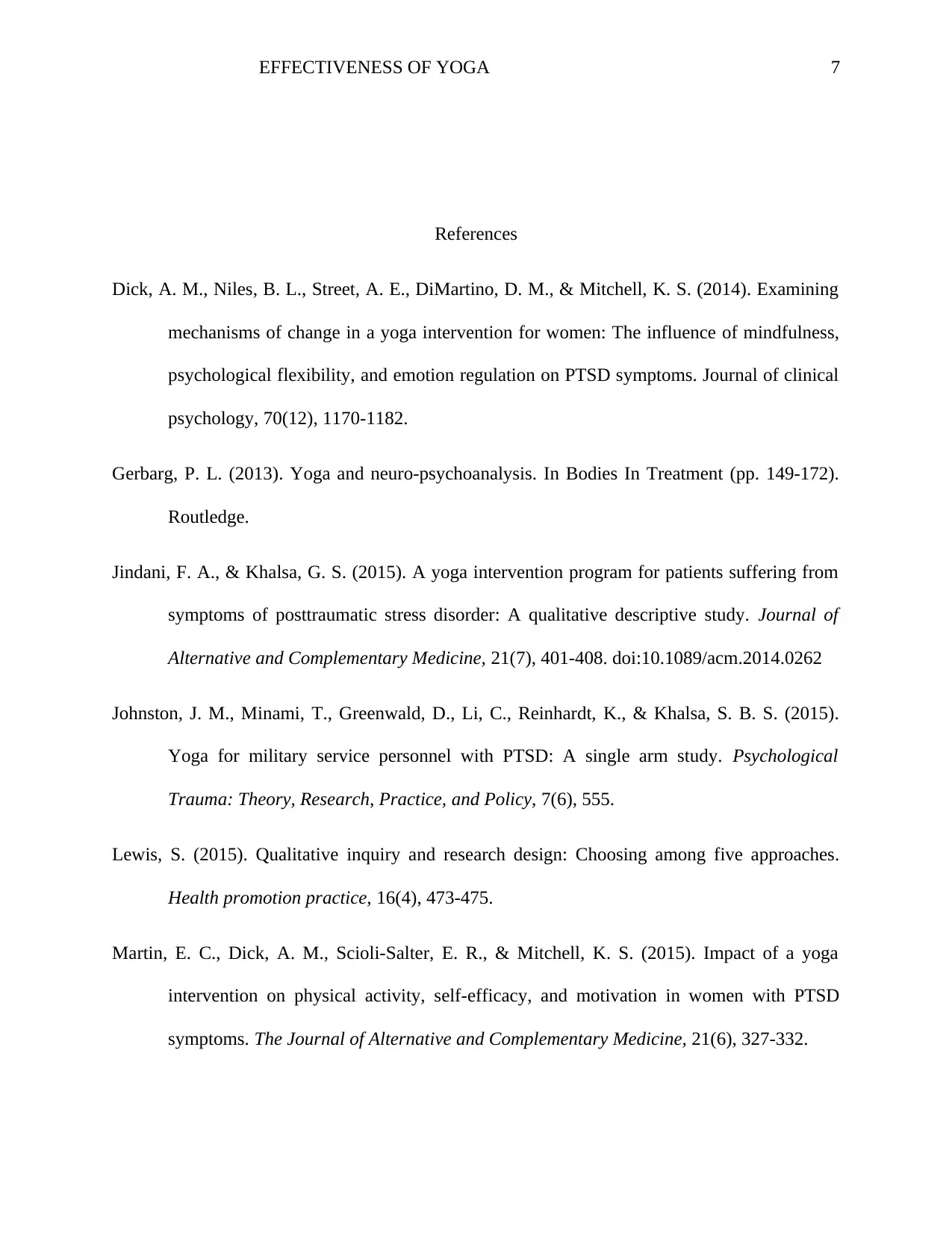
EFFECTIVENESS OF YOGA 7
References
Dick, A. M., Niles, B. L., Street, A. E., DiMartino, D. M., & Mitchell, K. S. (2014). Examining
mechanisms of change in a yoga intervention for women: The influence of mindfulness,
psychological flexibility, and emotion regulation on PTSD symptoms. Journal of clinical
psychology, 70(12), 1170-1182.
Gerbarg, P. L. (2013). Yoga and neuro-psychoanalysis. In Bodies In Treatment (pp. 149-172).
Routledge.
Jindani, F. A., & Khalsa, G. S. (2015). A yoga intervention program for patients suffering from
symptoms of posttraumatic stress disorder: A qualitative descriptive study. Journal of
Alternative and Complementary Medicine, 21(7), 401-408. doi:10.1089/acm.2014.0262
Johnston, J. M., Minami, T., Greenwald, D., Li, C., Reinhardt, K., & Khalsa, S. B. S. (2015).
Yoga for military service personnel with PTSD: A single arm study. Psychological
Trauma: Theory, Research, Practice, and Policy, 7(6), 555.
Lewis, S. (2015). Qualitative inquiry and research design: Choosing among five approaches.
Health promotion practice, 16(4), 473-475.
Martin, E. C., Dick, A. M., Scioli-Salter, E. R., & Mitchell, K. S. (2015). Impact of a yoga
intervention on physical activity, self-efficacy, and motivation in women with PTSD
symptoms. The Journal of Alternative and Complementary Medicine, 21(6), 327-332.
References
Dick, A. M., Niles, B. L., Street, A. E., DiMartino, D. M., & Mitchell, K. S. (2014). Examining
mechanisms of change in a yoga intervention for women: The influence of mindfulness,
psychological flexibility, and emotion regulation on PTSD symptoms. Journal of clinical
psychology, 70(12), 1170-1182.
Gerbarg, P. L. (2013). Yoga and neuro-psychoanalysis. In Bodies In Treatment (pp. 149-172).
Routledge.
Jindani, F. A., & Khalsa, G. S. (2015). A yoga intervention program for patients suffering from
symptoms of posttraumatic stress disorder: A qualitative descriptive study. Journal of
Alternative and Complementary Medicine, 21(7), 401-408. doi:10.1089/acm.2014.0262
Johnston, J. M., Minami, T., Greenwald, D., Li, C., Reinhardt, K., & Khalsa, S. B. S. (2015).
Yoga for military service personnel with PTSD: A single arm study. Psychological
Trauma: Theory, Research, Practice, and Policy, 7(6), 555.
Lewis, S. (2015). Qualitative inquiry and research design: Choosing among five approaches.
Health promotion practice, 16(4), 473-475.
Martin, E. C., Dick, A. M., Scioli-Salter, E. R., & Mitchell, K. S. (2015). Impact of a yoga
intervention on physical activity, self-efficacy, and motivation in women with PTSD
symptoms. The Journal of Alternative and Complementary Medicine, 21(6), 327-332.
Paraphrase This Document
Need a fresh take? Get an instant paraphrase of this document with our AI Paraphraser
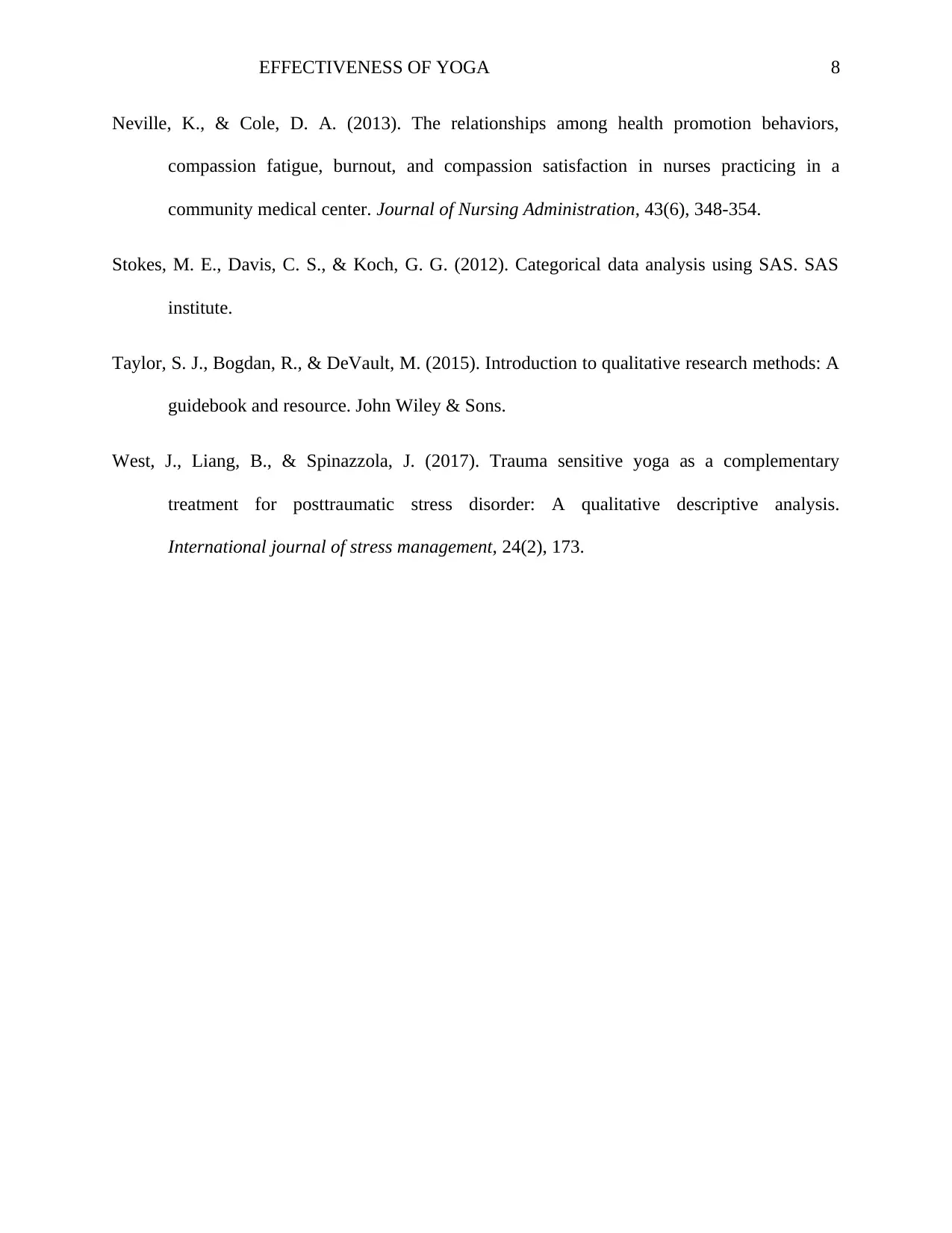
EFFECTIVENESS OF YOGA 8
Neville, K., & Cole, D. A. (2013). The relationships among health promotion behaviors,
compassion fatigue, burnout, and compassion satisfaction in nurses practicing in a
community medical center. Journal of Nursing Administration, 43(6), 348-354.
Stokes, M. E., Davis, C. S., & Koch, G. G. (2012). Categorical data analysis using SAS. SAS
institute.
Taylor, S. J., Bogdan, R., & DeVault, M. (2015). Introduction to qualitative research methods: A
guidebook and resource. John Wiley & Sons.
West, J., Liang, B., & Spinazzola, J. (2017). Trauma sensitive yoga as a complementary
treatment for posttraumatic stress disorder: A qualitative descriptive analysis.
International journal of stress management, 24(2), 173.
Neville, K., & Cole, D. A. (2013). The relationships among health promotion behaviors,
compassion fatigue, burnout, and compassion satisfaction in nurses practicing in a
community medical center. Journal of Nursing Administration, 43(6), 348-354.
Stokes, M. E., Davis, C. S., & Koch, G. G. (2012). Categorical data analysis using SAS. SAS
institute.
Taylor, S. J., Bogdan, R., & DeVault, M. (2015). Introduction to qualitative research methods: A
guidebook and resource. John Wiley & Sons.
West, J., Liang, B., & Spinazzola, J. (2017). Trauma sensitive yoga as a complementary
treatment for posttraumatic stress disorder: A qualitative descriptive analysis.
International journal of stress management, 24(2), 173.
1 out of 8
Related Documents
Your All-in-One AI-Powered Toolkit for Academic Success.
+13062052269
info@desklib.com
Available 24*7 on WhatsApp / Email
![[object Object]](/_next/static/media/star-bottom.7253800d.svg)
Unlock your academic potential
Copyright © 2020–2025 A2Z Services. All Rights Reserved. Developed and managed by ZUCOL.





